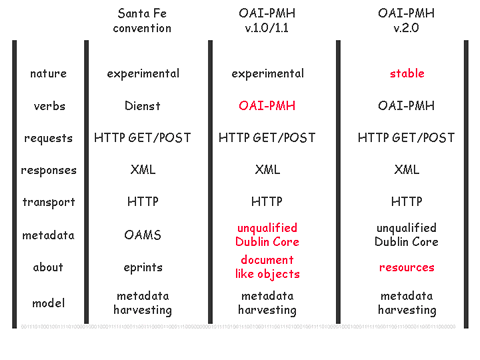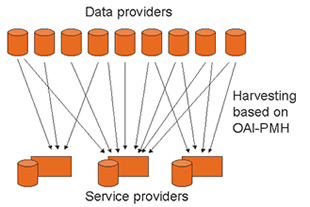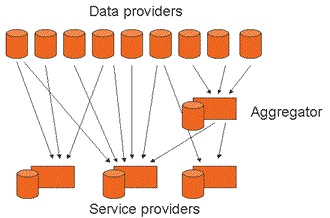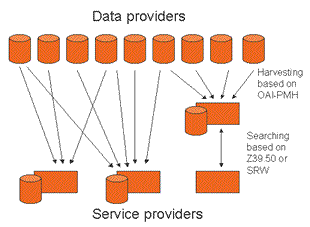Contents |
1 |
2 |
3 |
4 |
5 |
6 |
Previous |
Next
2. History and development of OAI-PMH
 Contents of this part of OAI for Beginners, the Open Archives Forum online tutorial
Contents of this part of OAI for Beginners, the Open Archives Forum online tutorial
The roots of OAI lie in the development of e-print repositories (so-called
archives). E-print repositories were established in order to communicate the
results of ongoing scholarly research prior to peer review and journal publication.
The earliest of these was xxx (later arXiv), which began with high energy physics
in 1991 and expanded to cover the field of physics plus related fields of mathematics,
nonlinear sciences and computer science. CogPrints followed for psychology,
linguistics and neuroscience. The Networked Computer Science Technical Reference
Library (NCSTRL) provided access to computer sciences technical reports deposited
either in xxx or in departmental repositories of cooperating research bodies.
Similarly, RePEc provided authors in the field of economics with the option
to submit working papers to their departmental archive or, if there was none,
to the EconWPA archive at Washington University. In addition, the Networked
Digital Library of Theses and Dissertations (NDLTD) built a digital library
of electronic theses and dissertations (ETDs) authored by students of member
institutions.
The mechanism for filling these repositories, in all cases, was by author deposit.
(Within the OAI, and for the purposes of this tutorial, an "e-print"
is defined as an author self-archived document.) Web interfaces allowed people
to interact with these repositories and some finding aids were provided. Different
interfaces were designed for different repositories, so end users were forced
to learn diverse interfaces in order to access the various repositories and
finding aids. The "Guildford protocol" supported interoperability
between the RePEc archives, while NCSTRL repositories implemented the Dienst
protocol. These protocols made possible a variety of end-user services, including
those supporting end-user search and browse across repositories in each grouping.
NDLTD created a workflow for submitting material, and developed an XML DTD (Document
Type Description) for electronic ETDs, as well as supporting a ETD digital library.
However, little or no autonomous metadata sharing was supported across this
diverse environment, and still further separate initiatives in the area of new
means of scholarly communication were taking shape. Certain key players in these
developments came to see interoperability as an increasingly important issue
to be addressed by the e-print community.
??the joint impact of these and future initiatives can be substantially higher
when interoperability between them [e-print archives] can be established??
(Ginsparg, Luce, Van de Sompel, UPS Call, July 1999)
Two key interoperability problems were identified as impairing the impact of
e-print archives: end users were faced with multiple search interfaces making
resource discovery harder, and there was no machine-based way of sharing the
metadata. Solutions that were being explored included cross-searching of archives
(on one hand) and harvesting archive metadata (on the other hand) in order to
provide centralised search services. In July 1999 Paul Ginsparg, Rick Luce,
and Herbert Van de Sompel of the Los Alamos National Laboratory issued a call
to a restricted group of technical experts to attend a meeting Santa Fe, New
Mexico in October of the same year. Ginsparg was involved with arXiv, and Van
de Sompel was also still associated with the University of Ghent at that time.
They proposed the creation of a universal service for author self-archived scholarly
literature (the Universal Preprint Service, or UPS). The UPS would be "the
fundamental and free layer of scholarly information, above which both free and
commercial services could flourish". The first steps toward establishing
it would be the identification or creation of interoperable technologies and
frameworks for the dissemination of e-prints. This was announced to a wider
audience under the headline "The Open Archives initiative aimed at the
further promotion of author self-archived solutions".
The aim of the meeting in Santa Fe was to discuss interoperability issues,
agree to begin work on a promotional prototype digital library service based
on the main existing e-print repositories, and establish a forum for continuing
work on interoperability of self-archiving solutions. In preparation for the
meeting, some foundational work was undertaken. Van de Sompel initiated a project
that simulated some aspects of interoperable distributed e-print archives. Thomas
Krichel (University of Surrey & RePEc) experimented with converting data from
existing e-print initiatives into the ReDIF metadata format used in RePEc. Michael
Nelson (NASA Langley) took this data and used it to create various archives
architected along the lines of his Smart Object Dumb Archives concepts. Data
used came from sources including CogPrints, NASA, NCSTRL, RePEc and xxx. The
aim of this work was not to make statements about the architectural directions
that the UPS should take, but rather to facilitate discussions about this at
the October meeting.
|
Challenges and proposed solutions
|
Top
|
Cross search or harvest?
Choice of a general direction to take in developing the architectural framework
for a UPS was a key issue at this early stage. Two possible approaches were
cross-searching multiple archives based on a protocol such as Z39.50, or else
harvesting metadata into one or more "central" services in a bulk
move of data that would bring it closer to the user interface.
Digital library experience suggested that cross searching does not scale well,
at least partly because the search service degrades to the level of the slowest
and least reliable server in the cross search set. For example, NCSTRL found
that distributed searching of a small number of nodes was viable, but that performance
was very bad over 100 nodes. In the UK, the Resource Discovery Network (RDN)
was finding that even with only five subject gateways in its cross search there
were problems of poor performance and in the provision of a browse interface,
and developers were looking for a feasible centralised database solution. The
more servers are cross-searched, the higher are the chances of encountering
one or more slow or unreliable servers.
There is also the problem of knowing which target servers to use in any particular
cross search. Collection descriptions – where they are available at all
– may be inconsistent across repositories, were not designed for machine-to-machine
communication and require time-consuming examination by end-users. Differences
in query language syntax and search attribute variation (between servers and
over time) introduce barriers of complexity, either for the end user or the
cross-search software, or both. Ranked merging of results from distributed servers
presents further technical and user-interface problems, and different size and
types of targets can skew results. A browse interface is very difficult to build
when the metadata to be browsed is distributed across a number of repositories.
It was suggested that a solution would be to get all the metadata records together
in one place.
The UPS prototype brought to the Santa Fe meeting demonstrated a cross-archive
digital library providing services based on a collection of metadata harvested
from multiple archives. Its architecture drew on NCSTRL and a modified version
of the Dienst protocol. In this way, the number of nodes being searched could
be reduced to one, giving significant performance benefits. A service could
be provided using one query language, set of search attributes and ranking algorithm.
In addition, an awareness of the data makes browse structures easier to build.
Data and Service Providers
The UPS architecture identified two logical roles: "Data Providers"
and "Service Providers". Data Providers handle the deposit and publishing
of resources in a repository and "expose" for harvesting the metadata
about resources in the repository. They are the creators and keepers of the
metadata and repositories of resources. Service Providers harvest metadata from
Data Providers. They use the harvested metadata for the purpose of providing
one or more services across all the data. The types of services that may be
offered include a search interface, peer-review system, etc. Note that one 'provider'
organisation can play both roles, offering both data for harvesting and end-user
services. The key architectural shift was the move away from only supporting
human end-user interfaces for each repository, to supporting both human end-user
interfaces and machine interfaces for harvesting.
|
The dawn of a protocol
|
Top
|
The name UPS (Universal Preprint Service) was quickly changed, partly in order
to avoid potential difficulties related to the fact that UPS is an established
brand name for a commercial parcel delivery service, and partly because it was
recognised that not all e-prints were preprints. The framework within which
this universal service would be developed was now designated the Open Archives
initiative – shortened to OAi, later OAI – a phrase that had gained
currency in early discussions.
It was clear from discussions and experiments that in order to facilitate metadata
harvesting there must be agreement on:
- a transport protocol – HTTP or FTP for example
- a metadata format – Dublin Core or MARC for example
- a basis for metadata quality assurance – mandatory element set, naming
and subject conventions, etc.
- intellectual property and usage rights – who can do what
with what?
An initial agreement in key areas made it possible to develop a protocol for
metadata harvesting, named the Santa Fe Convention in honour of the meeting
where this agreement was reached.
|
OAI-PMH version history
|
Top
|
 The
Santa Fe Convention was the first incarnation of the Open Archives Initiative
Protocol for Metadata Harvesting (OAI-PMH). It drew upon the UPS Prototype,
the RePEc/SODA Service/Data provider model, the Dienst Protocol, and the work
of the Santa Fe group. The focus of the Santa Fe Convention was to ?optimise
the discovery of e-prints?.
The
Santa Fe Convention was the first incarnation of the Open Archives Initiative
Protocol for Metadata Harvesting (OAI-PMH). It drew upon the UPS Prototype,
the RePEc/SODA Service/Data provider model, the Dienst Protocol, and the work
of the Santa Fe group. The focus of the Santa Fe Convention was to ?optimise
the discovery of e-prints?.
The OAI-PMH 1.0 introduced the unqualified Dublin Core element set as a baseline
for metadata interoperability. It drew upon the Santa Fe Convention, Digital
Library Federation meetings, work at Cornell University, and feedback from alpha-testers.
The focus expanded to facilitating the discovery of ?document-like objects".
It was a low barrier interoperability specification, based on a metadata harvesting
model. It was HTTP based, using HTTP GET / POST requests and XML responses.
Note that it is not a search protocol, rather, it is based on the metadata harvesting
model. OAI-PMH 1.1 was a revision of the 1.0 specification taking account of
changes to the emerging XML Schema specification. Both v.1.0 and 1.1 were experimental
in nature.
The OAI-PMH 2.0 is a major revision of the protocol, and is not compatible
with v.1.x. It drew upon OAI-PMH 1.x, feedback from OAI Implementers List, OAI
Tech deliberation, and feedback from alpha-testers. Once again the focus of
the protocol expanded; now it was said to be about ?the recurrent exchange of
metadata about resources between systems?. It is still a low barrier
interoperability specification based around a metadata harvesting model. No
longer experimental, v.2.0 is a stable protocol, and OAI has committed to making
subsequent revisions of the protocol backwards compatible.
|
Flexible deployment: various says OAI-PMH may be deployed
|
Top
|
OAI-PMH enables flexible deployment. Because it is a simple protocol based
on HTTP and XML, it allows for rapid deployment. A number of toolkits are available,
as will be discussed later in this tutorial. Systems can be deployed in a variety
of configurations, as illustrated in the following diagrams. Metadata and full-text
resources are typically made freely available, but this is not a requirement.
OAI-PMH can also be used between closed groups; for metadata-sharing only; and
in commercial applications.
Multiple Service Providers

Multiple Service Providers can harvest from multiple Data Providers.
Aggregators

Aggregators can sit between Data Providers and Service Providers.
Harvesting combined with searching

The harvesting approach can be complemented with searching based,
for example, on Z39.50 or SRW.
Early movers were developing separate solutions, but the need for interoperability
was recognised. In response, the Santa Fe Meeting led to substantial support
for the OAI, which promotes interoperability via developing OAI-PMH as an open
standard, and disseminating information about OAI-PMH. OAI-PMH is a low-cost
mechanism for harvesting metadata records from one system to another –
from Data Providers to Service Providers. Multiple Service Providers can harvest
from multiple Data Providers ensuring a wider spread of metadata. OAI-PMH is
not a search protocol, but its use can underpin search-based services; it is
a base layer on which to build other services.
Development over the last two to three years has seen a move from the specific
to the generic – from discovery of e-prints to sharing descriptions of
any resources. Although unqualified Dublin Core is specified for baseline interoperability,
OAI-PMH can be extended to any metadata format that can be encoded in XML. Based
on HTTP for requests (and access-control, compression, error codes, etc.) and
on XML for responses, it is Web-friendly, and therefore firewall friendly. It
allows Service Providers to say 'give me some or all of your records', where
'some' is based on date-stamps, sets, or metadata formats. Simple, and built
on existing technology, OAI-PMH is easy to deploy, with many toolkits that can
hide the protocol from developers.
|
Seven key definitions
|
Top
|
E-print
An e-print is an author self-archived document. In the sense that the term is
ordinarily used, the content of an e-print is the result of scientific or other
scholarly research.
Document-like object
A document-like object is a digital data unit that is comparable to a paper
document. The term designates a relatively simple stable resource, and would
not cover, for example multimedia artifacts or interactive services.
Resource
A resource is anything that has identity. Familiar examples include an electronic
document, an image, a service (e.g., today's "weather report for Los Angeles"),
and a collection of other resources. Not all resources are network "retrievable";
e.g., human beings, corporations, and bound books in a library can also be considered
resources.
(Definition from Guidelines
for implementing Dublin Core in XML by Andy Powell and Pete Johnston)
XML
XML is the acronym for Extensible Markup Language. XML is a language for creating
other languages. It defines a means of describing data. XML can be validated
against a DTD or schema setting out the elements of the language created. XML
mappings exist for a number of metadata record formats.
DTD
DTD is the acronym for Document Type Definition. A DTD is a formal specification
of the structure of a document.
Dublin Core
Dublin Core (DC) is a metadata format defined on the basis of international
consensus. The Dublin Core
Metadata Element Set defines fifteen elements for simple resource description
and discovery, all of which are recommended, and none of which are mandatory.
DC has been extended with further optional elements, element qualifiers and
vocabulary terms.
(Definition draws on UKOLN's metadata
glossary and Metadata
in a nutshell by Michael Day)
Interoperability
Interoperability is the ability of systems, services and organisations to work
together seamlessly toward common or diverse goals. In the technical arena it
is supported by open standards for communication between systems and for description
of resources and collections, among others. Interoperability is considered here
primarily in the context of resource discovery and access.
|
Sources of further information
|
Top
|
Articles
Lynch, C.A. Metadata Harvesting and the Open Archives Initiative. ARL Bimonthly
Report 217, August 2001
http://www.arl.org/newsltr/217/mhp.html
Van de Sompel, Herbert, Krichel, T., Nelson, M. L. and others. The UPS Prototype:
An Experimental End-User Service across E-Print Archives. D-Lib Magazine,
vol.6, no. 2. February 2000.
http://www.dlib.org/dlib/february00/vandesompel-ups/02vandesompel-ups.html
Van de Sompel, H., Lagoze, C. The Santa Fe Convention of the Open Archives
Initiative. D-Lib Magazine, vol.6, no.2. February 2000.
http://www.dlib.org/dlib/february00/vandesompel-oai/02vandesompel-oai.html
Web site
OAI Web site: http://www.openarchives.org/
Contents |
1 |
2 |
3 |
4 |
5 |
6 |
Previous |
Next
 The
Santa Fe Convention was the first incarnation of the Open Archives Initiative
Protocol for Metadata Harvesting (OAI-PMH). It drew upon the UPS Prototype,
the RePEc/SODA Service/Data provider model, the Dienst Protocol, and the work
of the Santa Fe group. The focus of the Santa Fe Convention was to ?optimise
the discovery of e-prints?.
The
Santa Fe Convention was the first incarnation of the Open Archives Initiative
Protocol for Metadata Harvesting (OAI-PMH). It drew upon the UPS Prototype,
the RePEc/SODA Service/Data provider model, the Dienst Protocol, and the work
of the Santa Fe group. The focus of the Santa Fe Convention was to ?optimise
the discovery of e-prints?. Contents of this part of OAI for Beginners, the Open Archives Forum online tutorial
Contents of this part of OAI for Beginners, the Open Archives Forum online tutorial


